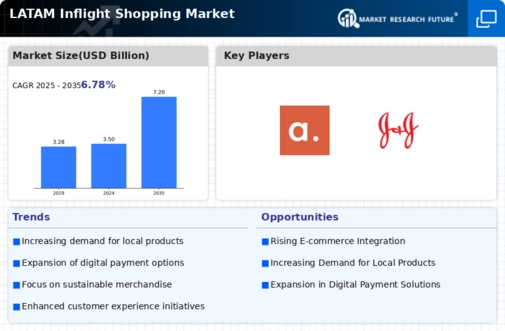Market Trends
Key Emerging Trends in the LATAM Inflight Shopping Market
The Latin America (LATAM) inflight shopping market has been witnessing notable trends and transformations in recent years, reflecting changes in consumer preferences, airline industry dynamics, and technological advancements. One significant trend in the LATAM inflight shopping market is the increasing adoption of digital and e-commerce platforms by airlines to enhance the shopping experience for passengers. With the proliferation of smartphones and onboard Wi-Fi connectivity, airlines are leveraging digital channels to offer a wide range of products and services, including duty-free items, luxury goods, and exclusive deals, directly to passengers during their flight. This shift towards digitalization not only provides passengers with greater convenience and accessibility but also enables airlines to generate additional revenue streams and strengthen their brand presence in the competitive aviation market.
Moreover, there is a growing emphasis on personalized and curated shopping experiences in the LATAM inflight shopping market, driven by advancements in data analytics and customer relationship management (CRM) technologies. Airlines are leveraging passenger data and preferences to tailor inflight shopping catalogs, recommend relevant products, and offer targeted promotions based on individual interests and purchasing behavior. By understanding passengers' preferences and purchase history, airlines can optimize their inflight retail offerings, maximize sales conversions, and enhance customer satisfaction, ultimately fostering loyalty and repeat business.
Additionally, the LATAM inflight shopping market is witnessing a rise in partnerships and collaborations between airlines, duty-free retailers, and luxury brands to expand product offerings and enhance the overall shopping experience for passengers. Airlines are forging strategic alliances with renowned brands and retailers to offer exclusive inflight collections, limited-edition products, and special promotions, thereby creating a unique selling proposition and driving passenger engagement. These partnerships not only enable airlines to differentiate themselves in the market but also provide passengers with access to premium and sought-after brands that may not be available through traditional retail channels.
Furthermore, the LATAM inflight shopping market is experiencing a shift towards sustainability and ethical consumerism, with airlines and retailers increasingly focusing on eco-friendly and socially responsible product offerings. There is a growing demand for environmentally friendly and ethically sourced products among passengers, prompting airlines to incorporate sustainable options such as organic skincare, recycled materials, and fair-trade goods into their inflight retail catalogs. By aligning with sustainable values and ethical principles, airlines can appeal to conscious consumers, enhance their corporate social responsibility (CSR) initiatives, and contribute to environmental conservation efforts.
Another notable trend in the LATAM inflight shopping market is the integration of contactless payment solutions and mobile wallet technologies to facilitate seamless and secure transactions onboard aircraft. With the ongoing COVID-19 pandemic prompting heightened hygiene and safety concerns, contactless payments have emerged as a preferred payment method among passengers, enabling them to make purchases without physical contact with cash or credit cards. Airlines are deploying NFC-enabled payment terminals and mobile payment platforms to enable passengers to pay for inflight purchases using their smartphones or wearable devices, providing a convenient and hygienic shopping experience while minimizing the risk of transmission.













Leave a Comment